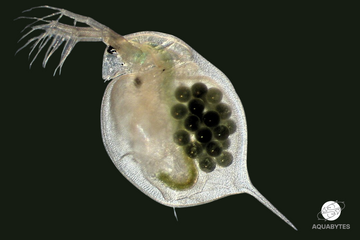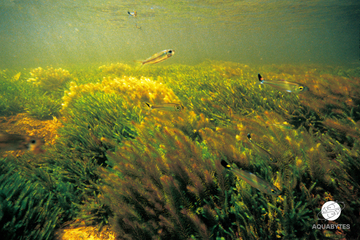The Scarlet Badis (Dario dario) stands out as one of the most captivating nano fish in the aquarium hobby. The Scarlet Badis is a shining example of a species that pairs aesthetic brilliance with behavioural complexity. While their care demands dedication and expertise, experienced aquarists who can meet their needs will find Dario dario to be a deeply rewarding centerpiece in a nano or biotope aquarium.
Natural Habitat and Distribution:
This species is endemic to the Brahmaputra River basin in northeastern India, particularly in the states of West Bengal and Assam. Dario dario naturally inhabits shallow, slow-moving streams and rivulets with clear water and sandy or gravelly beds. These environments are densely vegetated with aquatic species such as Limnophila, Hygrophila, Vallisneria, Ottelia, and Rotala. Leaf litter, roots, and detritus provide both cover and feeding grounds, supporting populations of microinvertebrates that make up the Scarlet Badis’ diet. Replicating these complex natural habitats in an aquarium setting is essential for long-term health and well-being.
Physical Characteristics

Male Scarlet Badis are particularly eye-catching, featuring intense red body stripes intersected by iridescent blue vertical bars. Their build is compact and slightly compressed laterally, and they typically grow to no more than 2 centimetres in length. Females are slightly smaller, with a more muted greyish hue and lack the extended fins seen in males. The species has 13–14 spines in the dorsal fin and 6–7 rays in the anal fin. These features, combined with their vivid sexual dimorphism, make Dario dario easy to distinguish from related species.
Behaviour and Compatibility

While generally peaceful, Scarlet Badis males can become quite territorial, especially in confined environments. Males will establish and guard small territories, often displaying vivid colours and engaging in posturing or short chases to assert dominance. In mixed tanks, their shy and slow-feeding nature puts them at a disadvantage, especially against more assertive or boisterous tankmates. For this reason, they are best housed in species-specific setups or with other gentle nano fish. Providing ample visual barriers and individual hiding spaces helps minimise stress and conflict.
Aquarium Care

To keep Scarlet Badis successfully, aquarists should replicate their natural habitat as closely as possible. A tank of at least 20 litres is recommended for a pair, although larger tanks are preferable when keeping multiple individuals to reduce territorial disputes. Use soft sand or fine gravel as substrate, and include dense planting, driftwood, and botanicals such as Indian almond leaves or oak leaves to create hiding spots and promote biofilm growth.
Water quality is critical. Maintain temperatures between 22–28°C, a pH of 6.0–7.5, and water hardness in the range of 2–12 dGH. Regular, gentle water changes and stable parameters are essential, as Scarlet Badis are sensitive to fluctuations and poor water quality. A gentle filter and subdued lighting will complete the setup, helping to mimic their shaded, slow-flowing native environment.
Diet and Feeding
Feeding is perhaps the most specialised aspect of Scarlet Badis care. In their natural habitat, they are micropredators feeding on tiny aquatic invertebrates. In captivity, they rarely accept dry or flake foods. Instead, a varied diet of live or frozen offerings—such as daphnia, baby brine shrimp, cyclops, or grindal worms—is necessary. Their small mouths and slow, deliberate feeding habits mean they are easily outcompeted, so tankmates must be carefully selected or avoided altogether.
Feeding should be done in small amounts, multiple times a day if possible, ensuring food is appropriately sized and accessible. Over time, some individuals may accept frozen food alternatives, but live feeding remains the gold standard for health and colour development.
Breeding

Despite their specialised care needs, Scarlet Badis (Dario dario) have been successfully bred in aquarium environments, often with minimal intervention. Given the right conditions — stable water parameters, a well-structured tank, and suitable male-to-female ratios — spontaneous breeding may occur even in community or display setups. Their breeding behaviour is both fascinating and indicative of the species' territorial nature.
Typically, during spawning periods, one male will assert dominance within the tank. This individual becomes noticeably more vibrant in colour and exhibits heightened aggression towards rival males. Courtship involves the dominant male displaying intense fin flaring and flashing his colours to attract a receptive female. If successful, spawning usually takes place on the underside of broad plant leaves or tank decorations. After fertilisation, the male will immediately drive the female away and establish a defensive perimeter around the nest site. While he does not provide direct care to the eggs or fry, he will guard the area until the eggs hatch.
To improve fry survival rates, it is advisable to remove the eggs from the main display tank and transfer them to a separate, well-established rearing tank with identical water conditions. The eggs typically hatch within 48–72 hours, and the fry become free-swimming shortly thereafter. Initially, they will rely on a yolk sac for sustenance during their first few days.
Once the yolk sac is depleted, fry should be offered infusoria or other microscopic live foods. As they grow, larger foods such as baby brine shrimp, microworms, or finely crushed prepared foods can be introduced. It is important to ensure food items are appropriately sized to avoid choking or digestive issues. When the juveniles are large enough to compete for food and avoid predation, they may be returned to the main tank or rehomed to other hobbyists.
Imported vs Wild-Caught
Scarlet Badis may be sourced either from the wild or through captive breeding, though neither option is widely available in the hobby. While there are no significant morphological differences between wild-caught and captive-bred individuals, wild specimens may exhibit slightly more intense coloration. However, wild-caught fish can be particularly challenging to acclimate to prepared or frozen foods. As such, aquarists must monitor feeding behaviour closely to ensure these fish are accepting food and are not exhibiting signs of malnourishment.




